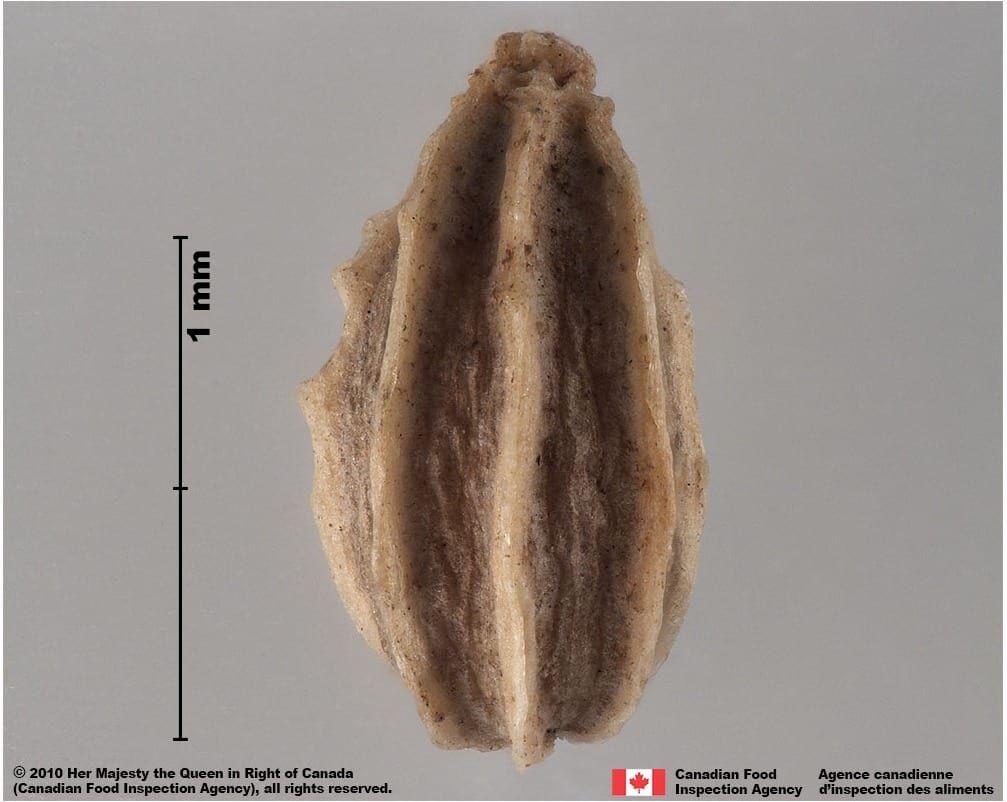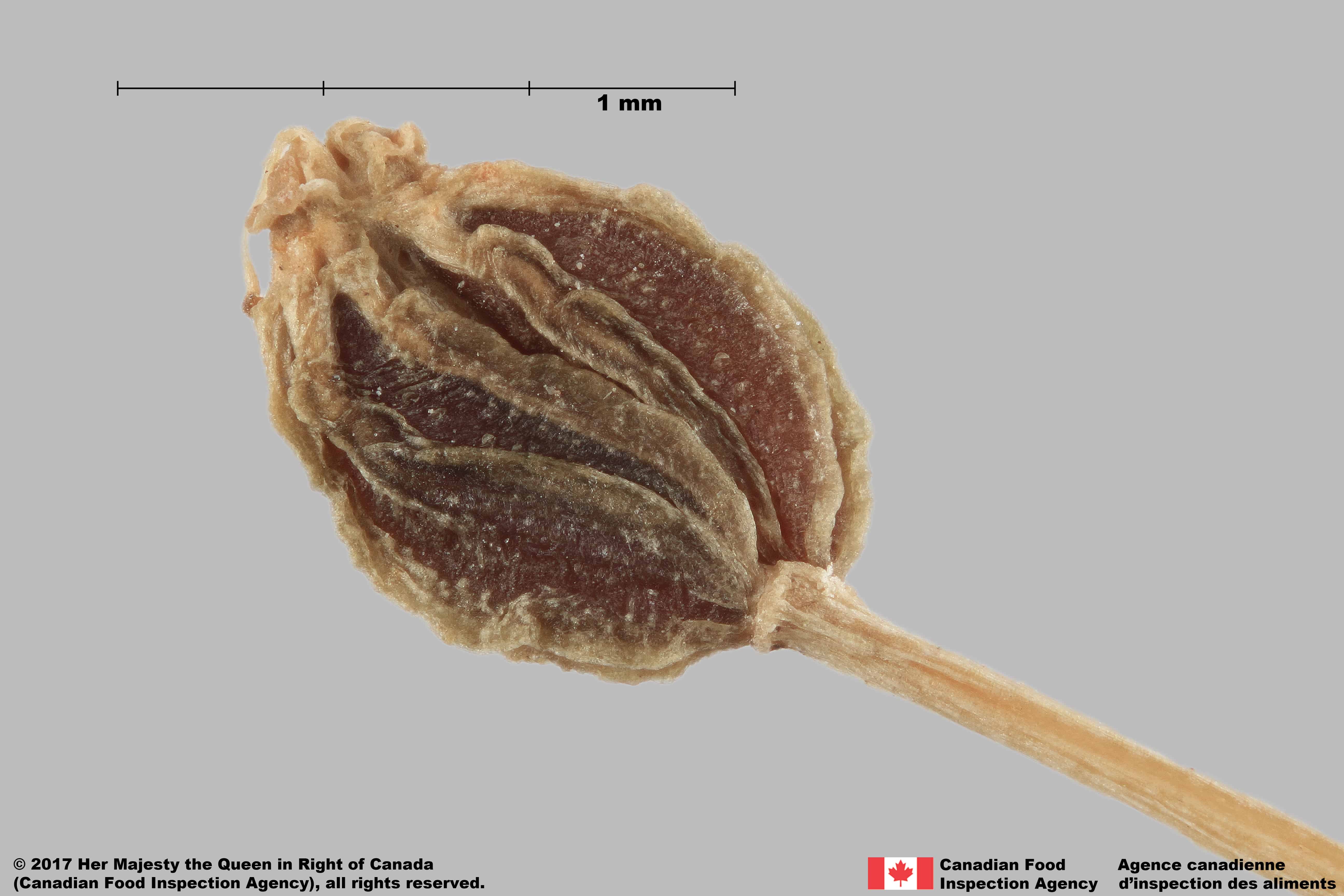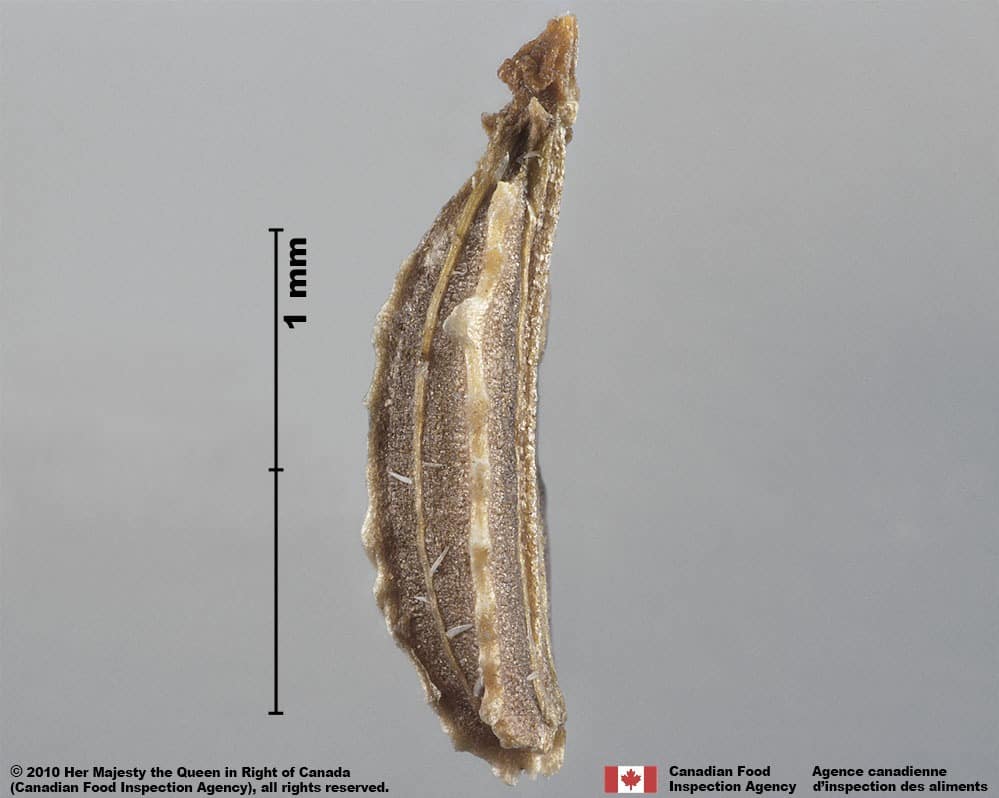Conium maculatum
Overview
Aperçu
Regulation :
Remarques Réglementation:
- CFIA Weed Seeds Order - Class 2: Primary Noxious Weed Seeds
- USA Federal Noxious Weed Seed List
Regulation Notes:
Distribution :
Répartition :
Native to northern Africa, Europe and western and central Asia. Introduced to North and South America, southern Africa, China, Australia, New Zealand and Micronesia (CABI 2022; USDA-ARS 2022). In Canada, it occurs in Alberta, British Columbia, New Brunswick, Nova Scotia, Ontario, Quebec and Saskatchewan (Brouillet et al. 2010+).
Habitat and Crop Association :
Habitat et Cultures Associées :
Cultivated fields, pastures, roads and disturbed areas (Darbyshire 2003; CABI 2022). It generally grows in non-crop areas, but can invade a variety of crops, including Zea mays subsp. mays (corn), Beta vulgaris subsp. vulgaris (sugar beet), Olea europaea (olive), Medicago sativa (alfalfa), Helianthus annuus (sunflower), Cicer arietinum (chickpea), as well as pastures and orchards, often by encroachment from field edges (CABI 2022).
Economic Use, cultivation area, and Weed Association :
Utilisation économique, zone de culture et association de mauvaises herbes :
Duration of Life Cycle :
Durée du cycle vital:
Biennial
Dispersal Unit Type :
Type d’unité de dispersion :
Schizocarp, divided into 2 mericarps
General Information
RENSEIGNEMENTS GÉNÉRAUX
Conium maculatum was brought to the United States as a garden plant in the 19th century (DiTomaso and Healy 2007). Mericarps spread by mud, boots and other human clothing, by machinery, transported soil and as a crop seed contaminant (BC MAFF 2002; CABI 2022).
C. maculatum grows in lowlands on dry to moist soils and can tolerate poorly drained soils (BC MAFF 2002). All parts of the plant are poisonous to livestock (CABI 2022).
.
Conium maculatum infestation (Joseph M. DiTomaso, University of California – Davis, Bugwood.org)
Identification
Identification
-
Mericarp
Size
- Mericarp length: 1.6 – 3.5 mm; width: 1.0 – 1.5 mm
*Note: minimum and maximum of 20 mericarps in a normal range of this species using image measurement (ISMA 2020)
Shape
- Oval, egg- or teardrop-shaped mericarp, plano-convex in 3 D view
Surface Texture
- Mericarp surface wrinkled
- Mericarp with 5 longitudinal wavy ridges on the convex side, and ridges do not come together at the wide end
- Mericarp with a deep longitudinal groove, no ridges, on the flat side
Colour
- Mericarp surface dull greyish-brown, brown or reddish brown
- Ridges straw yellow or whitish-yellow
Other Features
Mericarp end with style remnant
- Style remnant is short triangular shaped and dull straw yellow coloured
- A piece of connective tissue from between the mericarps may be attached to the style remnant
Other features
- Mericarp may be curved towards the flat side
- Musty smell if mericarp surface is punctured

Poison hemlock (Conium maculatum) mericarps








-
Seed
Size
- Seed is similar to the mericarp size
Shape
- Seed is oval, egg- or teardrop-shaped, plano-convex in 3-D view
Surface Texture
- Seed is smooth
- Seed with a deep longitudinal groove on the flat side
Colour
- Seed is grey coloured
Other Features
- Seed coat thin, transparent, adhering to the fruit wall
- Oil ducts are in a thin layer of tissue surrounding the seed
-
Embryo
Size
- Embryo is rudimentary size
Shape
- Embryo is linear
Endosperm
- Endosperm is hard and oily, translucent grey coloured
Other Features
- Embryo is in a basal position
Identification Tips
CONSEILS POUR L’IDENTIFICATION
The relatively small size, oval or egg-shape and the plano-convex shape in 3 dimensions are common for mericarps in the Apiaceae. The distinctive combination of features for Conium maculatum mericarps are greyish colour, wrinkled surface, wavy ridges and a deep groove on the flat side without ridges.
This groove can be seen in cross sections, and reaches almost to the middle of the mericarp with the oil ducts in a thin layer of tissue that surrounds the seed. The cross-section can be compared to similar species such as, Daucus carota subsp. carota and Petroselinum crispum, which do not have a deep groove on the flat face, nor the oil ducts in discrete longitudinal ridges around the seed.

Poison hemlock (Conium maculatum) mericarp, inner side








Additional Botany Information
AUTRES RENSEIGNEMENTS BOTANIQUES
Flowers/Inflorescence
Flowers are white, 2mm in diameter, with 5 notched petals that are arranged in umbels (CABI 2022)
Vegetative Features
- Erect, hollow, ribbed stems may reach up to 2 metres (sometimes 3 metres) in height and are often light green with purple spots (CABI 2022; King County 2022)
- Light green leaves resemble ferns (King County 2022)
- Tap root white or yellow, long and forked (CABI 2022)

Conium maculatum flowers and inflorescence (John Cardina, The Ohio State University, Bugwood.org)





Similar Species
ESPÈCES SEMBLABLES
Similar species are based on a study of seed morphology of various species, and those with similar dispersal units are identified. The study is limited by physical specimen and literature availability at the time of examination, and possibly impacted by the subjectivity of the authors based on their knowledge and experience. Providing similar species information for seed identification is to make users aware of similarities that could possibly result in misidentification.
Daucus carota subsp. carota L. (wild carrot)
D. carota subsp. carota mericarps are a similar size (length*: 1.7 – 3.5 mm; width: 1.1 – 2.2 mm), as C. maculatum but have straight ridges with small hairs, the surface is smooth, and the flat side has two ridges. C. maculatum mericarps ridges are wavy, the surface is wrinkled and it lacks ridges on the flat side.
*Note: D. carota subsp. carota mericarps may lack their typical long wings and hairs if processed, immature or damaged.
Petroselinum crispum (Mill.) Fuss (parsley)
P. crispum mericarps are a similar size (length*: 2.0 – 3.3 mm; width: 1.0 – 1.5 mm) as C. maculatum. P. crispum mericarp ridges are straight and come together at the wide end of the mericarp and the surface between the ridges (oil ducts) are smooth. C. maculatum mericarps have wavy ribs that do not meet at the end, a wrinkled surface and a deeper groove on the flat side of the mericarp than P. crispum.
*Note: minimum and maximum of 10 mericarps in a normal range of this species using image measurement (ISMA 2020)
Click to select species
Cliquez pour sélectionner les espèces

Daucus carota subsp. carota

Petroselinum crispum
Comparison Window
Fenêtre de comparaison
MAIN SPECIES
ESPÈCES PRINCIPALES
Conium maculatum

Conium maculatum
Apiaceae
Poison hemlock (Conium maculatum) mericarps
MAIN SPECIES
ESPÈCES PRINCIPALES
Conium maculatum

Conium maculatum
Apiaceae
Conium maculatum mericarps (both sides)
MAIN SPECIES
ESPÈCES PRINCIPALES
Conium maculatum

Conium maculatum
Apiaceae
Poison hemlock (Conium maculatum) mericarps
MAIN SPECIES
ESPÈCES PRINCIPALES
Conium maculatum

Conium maculatum
Apiaceae
Poison hemlock (Conium maculatum) mericarp, outer side
MAIN SPECIES
ESPÈCES PRINCIPALES
Conium maculatum

Conium maculatum
Apiaceae
Poison hemlock (Conium maculatum) mericarp, inner side
MAIN SPECIES
ESPÈCES PRINCIPALES
Conium maculatum

Conium maculatum
Apiaceae
Poison hemlock (Conium maculatum) mericarp; side view
MAIN SPECIES
ESPÈCES PRINCIPALES
Conium maculatum

Conium maculatum
Apiaceae
Poison hemlock (Conium maculatum) mericarp; top-down view
MAIN SPECIES
ESPÈCES PRINCIPALES
Conium maculatum

Conium maculatum
Apiaceae
Conium maculatum schizocarps
MAIN SPECIES
ESPÈCES PRINCIPALES
Conium maculatum

Conium maculatum
Apiaceae
Conium maculatum schizocarp
SIMILAR SPECIES
ESPÈCES SEMBLABLES
Daucus carota subsp. carota

Daucus carota subsp. carota
Apiaceae
Wild carrot (Daucus carota subsp. carota) mericarps
SIMILAR SPECIES
ESPÈCES SEMBLABLES
Daucus carota subsp. carota

Daucus carota subsp. carota
Apiaceae
Wild carrot (Daucus carota subsp. carota) mericarp, inner side
SIMILAR SPECIES
ESPÈCES SEMBLABLES
Daucus carota subsp. carota

Daucus carota subsp. carota
Apiaceae
Wild carrot (Daucus carota subsp. carota) mericarp, outer side
SIMILAR SPECIES
ESPÈCES SEMBLABLES
Daucus carota subsp. carota

Daucus carota subsp. carota
Apiaceae
Wild carrot (Daucus carota subsp. carota) mericarp, side view
SIMILAR SPECIES
ESPÈCES SEMBLABLES
Daucus carota subsp. carota

Daucus carota subsp. carota
Apiaceae
Wild carrot (Daucus carota subsp. carota) mericarp, example with long hairs
Need ID Help?
Besoin d’aide pour l’identification?
Reference(s)
Référence(s)
British Columbia Ministry of Agriculture, Food, and Fisheries (BC MAFF). 2002. Guide to the Weeds in British Columbia, https://www.for.gov.bc.ca/hra/Plants/weedsbc/GuidetoWeeds.pdf.
Brouillet, L., Coursol, F., Meades, S. J., Favreau, M., Anions, M., Bélisle, P. and Desmet, P. 2010+. VASCAN, the database of vascular plants of Canada. http://data.canadensys.net/vascan/ Accessed June 01, 2022.
Centre for Agriculture and Bioscience International (CABI). 2022. Invasive Species Compendium, CAB International, Wallingford, UK. https://www.cabidigitallibrary.org/journal/cabicompendium Accessed May 31, 2022.
Darbyshire, S. J. 2003. Inventory of Canadian Agricultural Weeds. Agriculture and Agri-Food Canada, Research Branch. Ottawa, ON.
DiTomaso, J. M. and Healy, E. A. 2007. Weeds of California and Other Western States. Vol. 1. 834 pp. University of California, CA.
Government of Canada (GC). 2016. Canadian Weed Seeds Order. https://laws-lois.justice.gc.ca/eng/regulations/SOR-2016-93/page-2.html (English) https://laws-lois.justice.gc.ca/fra/reglements/DORS-2016-93/page-2.html (French)
International Seed Morphology Association (ISMA). 2020. Method for Seed Size Measurement. Version 1.0. ISMA Publication Guide.
King County (Washington). 2022. https://kingcounty.gov/services/environment/animals-and-plants/noxious-weeds/weed-identification/poison-hemlock.aspx Accessed May 10, 2022.
Plants of the World Online (POWO). 2022. Facilitated by the Royal Botanic Gardens, Kew. Published on the Internet; http://www.plantsoftheworldonline.org/ Accessed May 10, 2022.
Tropicos. 2022. Missouri Botanical Garden. https://tropicos.org Accessed May 10, 2022.
U.S. Department of Agriculture-Agricultural Research Services (USDA-ARS). Germplasm Resources Information Network – (GRIN), https://npgsweb.ars-grin.gov/gringlobal/taxon/taxonomysimple.aspx Accessed May 31, 2022.




